- We get behind the wheel of the production version of the ID. Buzz
- Fully electric van with charming, voluminous interior
- Euro-market version shown, with U.S. model to follow next year
- Part of the first ID. Buzz generation introduced for 2024
First Drive of the 2024 Volkswagen ID. Buzz: Driving the World's Most Charismatic EV
Major cool factor yet thoroughly modern
What is the ID. Buzz?
The 2024 Volkswagen ID. Buzz is a fully electric small van that harkens back to the original VW Microbus — a cultural icon of the 1960s and '70s for its representation of a free and adventurous lifestyle. The front end's upright styling is clearly meant to evoke the style of Microbus, and you might see some 1990s VW Eurovan here, too. But otherwise the ID. Buzz is fully modern and offers the latest in EV technology.
The ID. Buzz shares its fundamental architecture with other electric vehicles from the Volkswagen Group lineup, including the ID.4 and Audi Q4 e-tron SUVs. What you get from picking the ID. Buzz over those models — besides a healthy dose of nostalgia — is extra family-oriented practicality. All U.S.-bound ID. Buzz models will feature three rows of seats.
Volkswagen plans to unveil the version coming to the U.S. in early 2023, with deliveries beginning in 2024.
What's powering the ID. Buzz?
We've only seen the European-market ID. Buzz so far, which is shorter than the eventual U.S. version. But the specs should all be quite similar. The ID. Buzz gets the same-sized 82-kWh battery pack (with 77 kWh of usable capacity) as the ID.4, and it powers an electric motor that drives the rear wheels. The single electric motor develops 201 horsepower and 229 lb-ft of torque to motivate this rather hefty van (weighing in at over 5,400 pounds) to a top speed of 90 mph. A dual-motor model will follow eventually and will likely offer a nice power bump to the tune of over 300 hp and 339 lb-ft of torque, in addition to providing all-wheel-drive traction.
Am I Ready for an EV?
- EV ownership works best if you can charge at home (240V outlet) This typically means a 240V home installation, or other places your car is parked for several hours each day. Don't expect a regular household outlet (120V) to suffice.
- Adding a home charging system is estimated to cost $1,616 in This is an estimate for your area. Using your address and the answers you provide, Treehouse can provide a more accurate price.
- Edmunds is partnering with Treehouse, an independent provider of home EV installation services. Learn more Edmunds customers receive a 10% installation discount and 4% smart charger discount. Discount excludes permit, hosted inspection, and load management devices. Valid for 30 days.
How does the ID. Buzz drive?
Here's a backhanded compliment: The ID. Buzz is a lot quicker than any of the original VW Microbuses. Tooling around town at lower speeds is where the Buzz is at its best — you have instant access to that 229 lb-ft of torque to get you moving quickly. But 201 hp is just not a whole lot considering the ID. Buzz's heft. The Buzz's power deficit is most noticeable in trying to reach highway speeds quickly or, worse, when trying to pass at highway speeds.
Volkwagen states that accelerating to 62 mph (100 km/h) from a standstill takes 10.2 seconds, which is pretty slow by modern minivan standards and even slower by current EV standards. In Edmunds' instrumented testing, it takes the average minivan 7.9 seconds to accelerate from 0 to 60 mph, while mainstream EVs, on average, require only 7.5 seconds. Weight, of course, plays a large part. The ID. Buzz is already down a bit on power compared to other minivans, and it's also about 600-700 pounds heavier. We're not in love with the brakes — it can be hard to stop smoothly. The regenerative braking won't bring you to a full stop either.
On the upside, the ID. Buzz has relatively taut handling for a van. Credit goes to the floor-mounted battery pack that keeps the van's center of gravity low. It's not sporty, but it is easy to wheel around town. It also has a ridiculously tight turning circle that'll make you want to do U-turns all day.
How comfortable is the ID. Buzz?
The ID. Buzz is fairly comfortable, but there's room for improvement. We like that the front seats are well cushioned and decently adjustable, from four-way lumbar support to an extendable lower thigh cushion for those with longer legs. Our test van had seat heaters and even provided a light seat massage via pneumatic bladders in the cushions. For those of us living in sunnier places, though, a seat ventilation option would be nice.
Unfortunately, the rear bench seat isn't nearly as comfortable as the front. The cushions are firmer and don't have as much shape to them. And, at least on the European version we drove, there were no second-row air vents or rear windows that rolled down or even cracked open. The outboard armrests feel out of reach, and there's no flip-down center armrest either.
The ride quality if you're in the front is pretty decent since you're closer to the middle of the Buzz's long wheelbase. But the ride definitely feels a bit stiff in the second row. Packed with rear passengers and cargo, though, we'd expect the rear suspension to cope better since it's crafted to handle a large load.
We found the cabin to be fairly well insulated against all types of noises. There was a bit of wind noise at the front while we were driving down the highway, and tire noise was largely dependent on the surface texture of the road, but it was easy to carry a conversation at any point without having to raise our voices.
How's the ID. Buzz's interior?
The exterior design of the ID. Buzz is certainly eye-catching, but we think we might like the interior design even more. The model we drove was packed with personality — it featured a wide range of textures, wood-grain patterns and pastel colors throughout the interior. Like french fries and ice cream, it sounds like it shouldn't work but it's surprisingly good. There are also playful icons, including several Easter eggs — ID. Buzz silhouettes — and even an embossed smiley face to liven up lowly door-trim screw caps. We also love VW's clever "Play" and "Pause" symbols on the accelerator and brake pedals. The ID. Buzz may win over buyers on charisma alone.
Charisma aside, we do think the amount of hard plastics used throughout the interior detract from the stunning design. With the exception of the armrests, seats and headliner, nearly all of the touchpoints in the ID. Buzz cabin are hard plastic. We think there are smart ways around all this plastic without raising costs too much (just look at any new Kia or Hyundai interior) and implementing them in the ID. Buzz would go a long way.
Space, however, is a major strength in the ID. Buzz. Even the short-wheelbase version that we sampled had plenty of room for taller drivers and passengers in both rows. The second row slides forward or backward a few inches, and the seatbacks recline, allowing passengers to find a comfortable position. We'll have to reserve judgment on the longer-wheelbase version with a third row of seats that's bound for the U.S. market. But with its estimated 8 inches of additional wheelbase length, we anticipate it to be relatively passenger-friendly. We also confirmed that there will be air vents for third-row passengers, so you may have people calling dibs on the rear row.
How's the ID. Buzz's tech?
Just like the ID.4, a 10-inch center display comes standard on European models, and a 12-inch display is optional. This setup will likely carry over to North America. There is also a small digital display in front of the driver to show speed, battery levels, navigation and other information.
The overall look is very similar to that of the ID.4 and carries forward a major complaint that we've had in recent Volkswagen models: an absence of physical buttons and dials. It opts instead for capacitive touch controls. They tend to lack responsiveness, sometimes require tapping over and over again, and can generally be frustrating to use. The ID. Buzz we drove had the latest software and indeed seemed to have snappier input response, but fundamental operation is still much more finicky than it should be. At this point we're not entirely confident this issue is something that can be solved solely through software updates.
IQ.Drive, VW's advanced driver aid suite, is here as well. We like how the majority of the aids operate. Adaptive cruise control, for instance, is pretty handy especially in slow-moving traffic. Lane keeping assistance, though, was too quick to intervene, and we had to disable it every time we powered up the car. The ability to store your system settings is something we hope to see in the future.
How's the ID. Buzz's storage?
Storage is one of the main reasons to consider buying an ID. Buzz. Up front, there are large pockets and rubberized trays to store small items, including a deep well next to the steering wheel for slipping your smartphone inside vertically. USB charge ports abound here as well, with four ports up front and one at each sliding door in the back. There is also a center storage bin that features folding openings at the front and rear and configurable cupholders, and it can be fully removed very easily to create a clear path to the second row. We're pretty interested to see what sort of accessories or attachments the aftermarket cooks up for that spot.
The cargo area behind the second row of seats is inarguably large. At 39.6 cubic feet, according to Volkswagen's specs, it's far more space than what's behind the third row of the Chevrolet Tahoe (25.5 cubes) and just shy of the most spacious minivan on the market, the Kia Carnival (40.2 cubes). The van's upright shape gives it a low load floor and high ceiling. There's also a wide opening and deep volume from the hatch to the rear seats. Adding a third row of seats will certainly have some effect on cargo space, but we're confident the space should still be pretty ample. The second row splits and folds down, and we imagine the third row will do the same to create a flat load space over the seatbacks. Perfect for, say, a small van-sized mattress of sorts.
How economical is the ID. Buzz?
When it comes to electric vehicles, range is the number that people focus on over efficiency, mainly because the cost of electricity is still a fraction of what we pay to fill up a gas tank. While we are still far from having any meaningful range and efficiency numbers for the U.S.-market models, we did some back-of-the-napkin math on the European WLTP numbers for the European model that Volkswagen provided and took into account what we've seen in the VW ID.4 models we've tested.
By our math, we think the European single-motor rear-wheel-drive ID. Buzz would get an EPA-estimated range of 200 miles and efficiency of around 39 kWh/100 miles. We've heard whispers that U.S. versions of the ID. Buzz will also be getting larger battery packs, so we're hopeful that'll make them more road trip-worthy. In Edmunds' real-world EV range testing, we've seen on average 13% more range in the ID.4 than its EPA estimate. So it's possible we could see the same performance results out of the ID. Buzz.
As far as charging goes, the ID. Buzz will be able to support up to 11 kW of Level 2 AC charging, as well as 170 kW at a DC fast charger. In terms of time, you'll be able to charge from zero to 100% in a few as 7.5 hours at home and from 5% battery to 80% capacity in as little as 30 minutes given the right conditions at a DC fast charger.
Edmunds says
There is a major cool factor with the ID. Buzz. It preserves enough of the original Microbus' mojo and packages it into something that looks thoroughly modern and is extremely versatile. In person, its charm is undeniable, even with some of the cheap interior plastics and glitchy electronics. And though it's far from the quickest EV or minivan, the ID. Buzz is destined to have a massive cult following when it eventually arrives in North America in 2024.





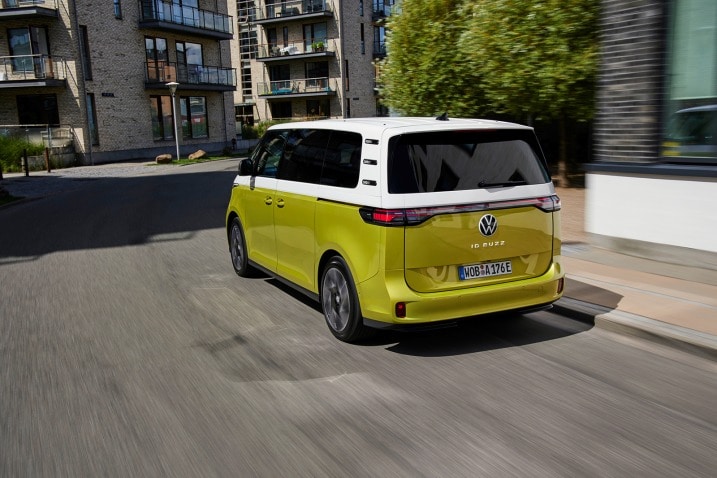
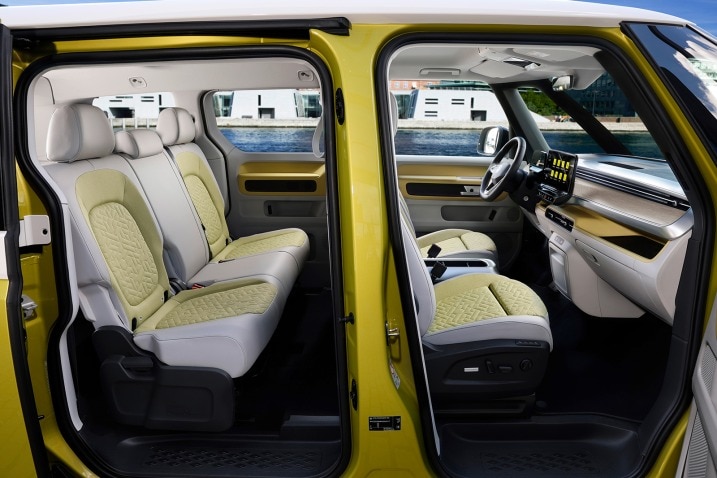
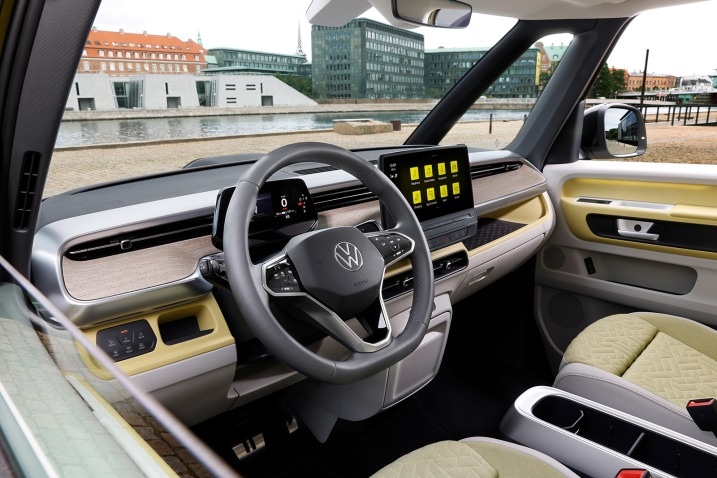
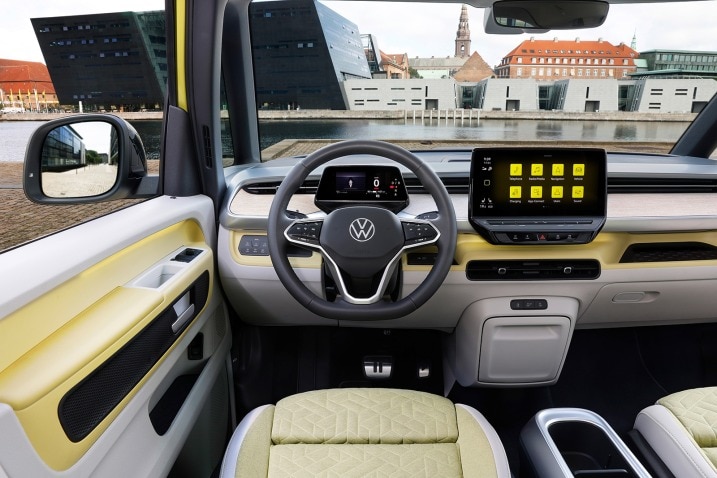

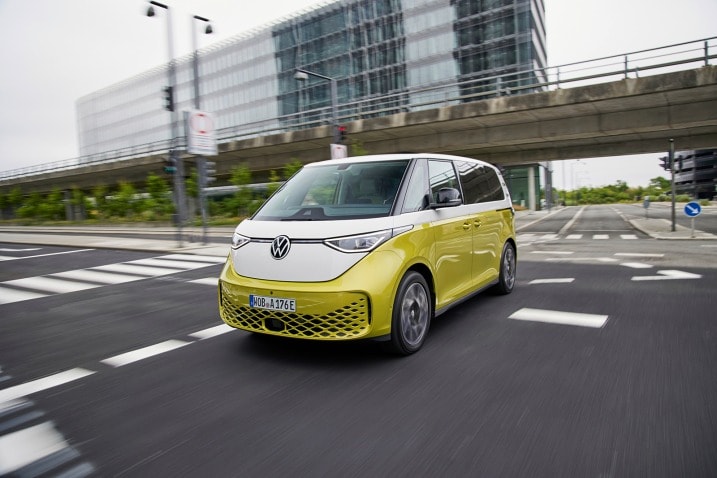
 by
by